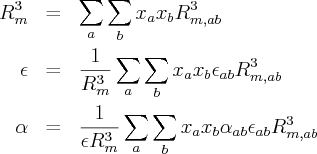pair_style exp6/rx command
Syntax
pair_style exp6/rx cutoff
- cutoff = global cutoff for DPD interactions (distance units)
Examples
pair_style exp6/rx 10.0 pair_coeff * * exp6.params h2o h2o 1.0 1.0 10.0 pair_coeff * * exp6.params h2o 1fluid 1.0 1.0 10.0 pair_coeff * * exp6.params 1fluid 1fluid 1.0 1.0 10.0
Description
Style exp6/rx is used in reaction DPD simulations, where the coarse-grained (CG) particles are composed of m species whose reaction rate kinetics are determined from a set of n reaction rate equations through the fix rx command. The species of one CG particle can interact with a species in a neighboring CG particle through a site-site interaction potential model. The exp6/rx style computes an exponential-6 potential given by

where the epsilon parameter determines the depth of the potential minimum located at Rm, and alpha determines the softness of the repulsion.
The coefficients must be defined for each species in a given particle type via the pair_coeff command as in the examples above, where the first argument is the filename that includes the exponential-6 parameters for each species. The file includes the species tag followed by the alpha, epsilon and Rm parameters. The format of the file is described below.
The second and third arguments specify the site-site interaction potential between two species contained within two different particles. The species tags must either correspond to the species defined in the reaction kinetics files specified with the fix rx command or they must correspond to the tag “1fluid”, signifying interaction with a product species mixture determined through a one-fluid approximation. The interaction potential is weighted by the geometric average of the concentrations of the two species. The coarse-grained potential is stored before and after the reaction kinetics solver is applied, where the difference is defined to be the internal chemical energy (uChem).
The fourth and fifth arguments specify the Rm and epsilon scaling exponents.
The final argument specifies the interaction cutoff.
The format of a tabulated file is as follows (without the parenthesized comments):
# exponential-6 parameters for various species (one or more comment or blank lines)
h2o exp6 11.00 0.02 3.50 (species, exp6, alpha, Rm, epsilon)
no2 exp6 13.60 0.01 3.70
...
co2 exp6 13.00 0.03 3.20
A section begins with a non-blank line whose 1st character is not a “#”; blank lines or lines starting with “#” can be used as comments between sections.
Following a blank line, the next N lines list the species and their corresponding parameters. The first argument is the species tag, the second argument is the exp6 tag, the 3rd argument is the alpha parameter (energy units), the 4th argument is the epsilon parameter (energy-distance^6 units), and the 5th argument is the Rm parameter (distance units). If a species tag of “1fluid” is listed as a pair coefficient, a one-fluid approximation is specified where a concentration-dependent combination of the parameters is computed through the following equations:

where

and xa and xb are the mole fractions of a and b, respectively, which comprise the gas mixture.
Mixing, shift, table, tail correction, restart, rRESPA info:
This pair style does not support mixing. Thus, coefficients for all I,J pairs must be specified explicitly.
This style does not support the pair_modify shift option for the energy of the exp() and 1/r^6 portion of the pair interaction.
This style does not support the pair_modify tail option for adding long-range tail corrections to energy and pressure for the A,C terms in the pair interaction.
Restrictions
This command is part of the USER-DPD package. It is only enabled if LAMMPS was built with that package. See the Making LAMMPS section for more info.